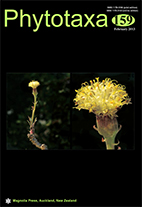Abstract
The genus Riella (Riellaceae, Sphaerocarpales) includes some 24 species of thalloid aquatic liverworts with unique morphological and ecological features among hepatics. These include the development of sporophytes enclosed within involucres and growing submerged in seasonal fresh or brackish water ponds. Riella subgenus Trabutiella includes species with winged involucres. Seven taxa have been described, however, four to five taxa have been recognized at a time depending on authors. In this study we have conducted a morphological revision of the species of this subgenus, based on 59 traits measured under light and Scanning Electron Microscopy analyses and that were the subject of statistical analyses. Taxonomically most informative traits were derived from female involucres and spores, whereas quantitative vegetative traits were of little relevance to taxonomy. Lectotypes are designated for subgenus Trabutiella and section Plicatae and for R. cossoniana. Our analyses support the recognition of six species, and support R. paulsenii as a synonym of R. cossoniana. A new species, R. mediterranea is described, and R. cossoniana var. echinata is raised to species rank. An identification key, detailed descriptions of the six accepted taxa, updated distribution maps, and full illustrations of four of the species, including the first for R. echinata are provided.

